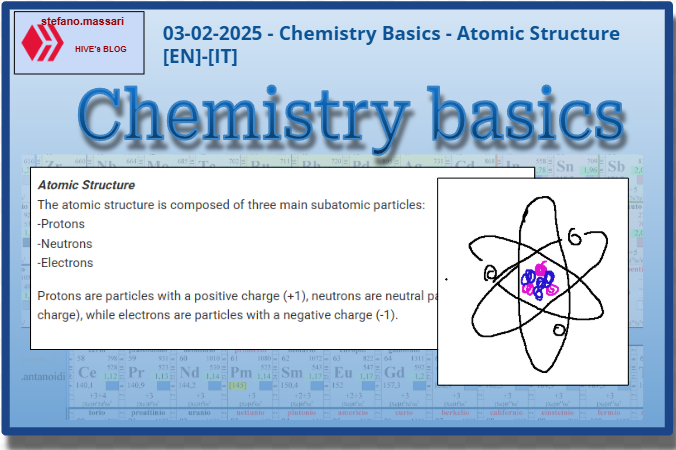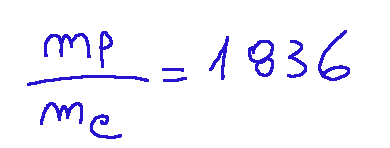03-02-2025 - Chemistry Basics - Atomic Structure [EN]-[IT]

~~~ La versione in italiano inizia subito dopo la versione in inglese ~~~
ENGLISH
03-02-2025 - Chemistry Basics - Atomic Structure [EN]-[IT]
With this post I would like to give a brief instruction about the topic mentioned in the subject
(code notes: X_97)
Atomic Structure
The atomic structure is composed of three main subatomic particles:
-Protons
-Neutrons
-Electrons
Protons are particles with a positive charge (+1), neutrons are neutral particles (without charge), while electrons are particles with a negative charge (-1).

Here are some information pills regarding the subject in question.
1-electron
Relative to the charge and mass of the proton, an electron has the opposite charge and a smaller mass. The charge of the electron is -1.6 x 10^-19 C.
2-mass of the electron
The mass of the electron is 9.11×10^-31 kg
3-Rutherford's gold foil
In Rutherford's experiment, a thin gold foil is bombarded with alpha particles. If the structure of the atom had been that proposed by
Thomson, it should have happened that the alpha particles would have passed through the foil with practically no deviations.
Rutherford's experiment demonstrated that the atom has a dense and positively charged nucleus, which causes significant deviations of some alpha particles.
4-Rutherford's experiment
Rutherford's experiment establishes that the protons, with a positive charge, are found in a region called the nucleus, small compared to the characteristic dimensions of the atom.
This experiment clarified that the nucleus of the atom contained the protons (positively charged), only later was it discovered that neutrons too.
5-The panettone
It was the scientist Joseph John Thomson who proposed the atomic model called "panettone". Thomson proposed the panettone model in 1904, hypothesizing that the atom was a positively charged sphere with electrons immersed inside it, similar to a "panettone" or also known as "plum pudding"
6-The atom is essentially empty
Rutherford, through his famous "gold foil" experiment, understood that the atom is essentially empty. The positive charge is found at the center of the atom.
7-Alpha rays
Alpha rays are Helium nuclei (He2).
Alpha rays are made up of helium nuclei, i.e. two protons and two neutrons, without electrons, therefore with a charge of +2.
Alpha rays were fundamental in the discovery of the atomic structure thanks to Rutherford's experiment. By observing how they were deflected or bounced, Rutherford was able to deduce the existence of the atomic nucleus and reveal that the atom is largely empty
8-proton/mass
The ratio of proton mass to electron mass is 1833.
The ratio of the mass of the proton to the mass of the electron is approximately:

However, the most commonly used value in chemistry and physics is 1833, which is an accepted approximation.
Conclusions
The first scientists who contributed to identifying the structure of the atom were:
John Dalton with his Indivisible Atomic Model (1803)
J.J. Thomson with his Panettone Model (1897)
Ernest Rutherford with his Nuclear Model (1911)
Question
I remember that the discovery of the structure of the atom was one of those things that fascinated me most in chemistry. Do you remember when you studied the atom at school?

[ITALIAN]
03-02-2025 - Basi di chimica - Struttura atomica [EN]-[IT]
Con questo post vorrei dare una breve istruzione a riguardo dell’argomento citato in oggetto
(code notes: X_97)
Struttura atomica
La struttura atomica è composta da tre principali particelle subatomiche:
-Protoni
-Neutroni
-Elettroni
I protoni sono particelle con carica positiva (+1), i neutroni sono particelle neutre (senza carica), mentre gli elettroni sono particelle con carica negativa (-1).

Qui di seguito alcune pillole di informazioni a riguardo dell’argomento in oggetto.
1-elettrone
Relativamente alla carica e alla massa del protone, un elettrone ha carica opposta e massa minore. La carica dell'elettrone è di -1,6 x 10^-19 C.
2-massa dell'elettrone
La massa dell'elettrone vale 9.11×10^-31 kg
3-La lamina d'oro di Rutherford
Nell'esperimento di Rutherford una sottile lamina d'oro viene bombardata con particelle alfa. Se la struttura dell'atomo fosse stata quella proposta da
Thomson sarebbe dovuto accadere che le particelle alfa avrebbero attraversato la lamina praticamente senza deviazioni.
L'esperimento di Rutherford dimostrò che l'atomo ha un nucleo denso e carico positivamente, che causa deviazioni significative di alcune particelle alfa.
4-L'esperimento di Rutherford
L'esperimento di Rutherford stabilisce che i protoni, di carica positiva, si trovano in una regione chiamata nucleo, piccola rispetto alle dimensioni caratteristiche dell'atomo.
Questo esperimento chiarì che il nucleo dell'atomo conteneva i protoni (carichi positivamente), solo successivamente si scoprì che anche i neutroni.
5-Il panettone
Fu lo scienziato Joseph John Thomson ha proporre il modello atomico detto "a panettone". Thomson propose il modello a panettone nel 1904, ipotizzando che l'atomo fosse una sfera carica positivamente con elettroni immersi al suo interno, simile a un "panettone" o conosciuto anche con il nome "plum pudding"
6-L'atomo è essenzialmente vuoto
Rutherford, attraverso il suo famoso esperimento "della lamina d'oro", comprese che l'atomo è essenzialmente vuoto. La carica positiva si trova al centro dell'atomo.
7-I raggi alfa
I raggi alfa sono Nuclei di elio (He2).
I raggi alfa sono costituiti da nuclei di elio cioè due protoni e due neutroni, privi di elettroni, quindi con carica +2.
I raggi alfa furono fondamentali nella scoperta della struttura atomica grazie proprio all'esperimento di Rutherford. Attraverso l'osservazione di come venivano deviati o rimbalzati, Rutherford riuscì a dedurre l'esistenza del nucleo atomico e a rivelare che l'atomo è in gran parte vuoto
8-protone/massa
Il rapporto massa protone/massa elettrone vale 1833.
Il rapporto tra la massa del protone e la massa dell'elettrone è approssimativamente:

Tuttavia, il valore più comunemente usato in ambito chimico e fisico è 1833, che è un'approssimazione accettata.
Conclusioni
I primi scienziati che contribuirono ad individuare la struttura dell'atomo furono:
John Dalton con il suo Modello atomico indivisibile (1803)
J.J. Thomson con il suo Modello a panettone (1897)
Ernest Rutherford con il suo Modello nucleare (1911)
Domanda
Io ricordo che la scoperta della struttura dell'atomo fu una di quelle cose che mi appassionò di più in chimica. Vi ricordate quando a scuola avete studiato l'atomo?
THE END
Congratulations @stefano.massari! You have completed the following achievement on the Hive blockchain And have been rewarded with New badge(s)
You can view your badges on your board and compare yourself to others in the Ranking
If you no longer want to receive notifications, reply to this comment with the word
STOPCheck out our last posts:
I remember many years ago, this is my favourite topic in chemistry. Atomic structure
I have always liked the story of the evolution of the discovery of the atom involving Dalton, Thomson and Rutherford.
Even before getting to the stage of studying chemistry
I studied atom already
It’s an interesting course
Tahnks for stopping by. Chemistry is something that has always fascinated me even though I don't fully understand some concepts.